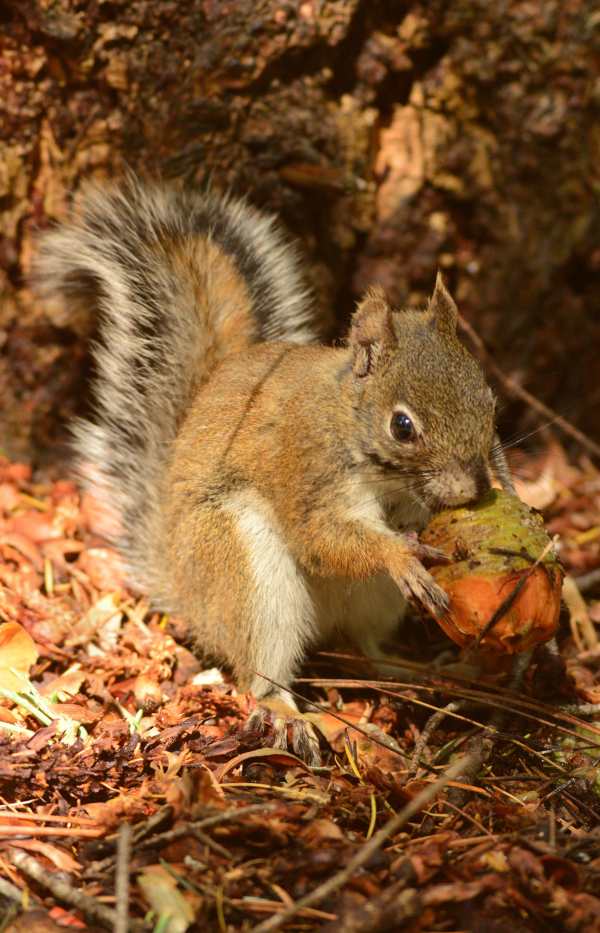
|
PHOENIX — Arizona’s embattled Mount Graham red squirrel population grew 4% in 2019, providing proof that the endangered squirrel continues its fight back two years after nearly being wiped out by a devastating wildfire.
The stabilization of the population over the past year comes after much of the territorial squirrel’s habitat was severely damaged in 2017 by the Frye Fire in the Pinaleño Mountains in southeastern Arizona. In September, the annual survey found a minimum estimate of 78 squirrels, which is in line with the 75 squirrels found in 2018.
Download squirrel b-roll and an interview with AZGFD biologist Tim Snow
Download photos by AZFD photographer George Andrejko
“Much work must be done to help conserve and protect this resilient, intrepid animal, but consistent estimates of the population since the fire are encouraging for the Mount Graham red squirrel’s overall recovery,” said Tim Snow, AZGFD terrestrial wildlife specialist. “This squirrel has faced significant, daunting challenges, but the Arizona Game and Fish Department and our partners will continue our work to give it a fighting shot at survival.”
The annual population estimate is made by monitoring all known midden locations for activity. The middens — areas where red squirrels store their spruce, fir and pinecone cache for the upcoming winter — are then surveyed every fall by the Arizona Game and Fish Department, Coronado National Forest, U.S. Fish and Wildlife Service, Arizona Center for Nature Conservation – Phoenix Zoo, and the University of Arizona.
"We really appreciate the hard work that all of our partners are doing to ensure the endangered Mount Graham red squirrel continues to be a part of Arizona’s incredible diversity of wildlife,” said Marit Alanen, U.S. Fish and Wildlife Service biologist. “Ensuring its recovery will take a lot of effort, but it’s through collaborations between multiple agencies and partners that will ultimately be able to recover the squirrel."
The Mount Graham red squirrel is a subspecies that can only be found in the upper elevation conifer forests of the Pinaleño Mountains. The squirrel’s population peaked at about 550 in the late 1990s, but typically ranged between 200 and 300 before the Frye Fire.
The subspecies was thought to have been extinct in the 1950s, but was rediscovered decades later and granted protection under the Endangered Species Act in 1987.
Its diet consists primarily of conifer seeds, but also includes insects, mushrooms, bird eggs, nestlings and other items. Mount Graham red squirrels are highly territorial and will aggressively defend their middens or food cache. In addition, they have lower reproductive rates and a shorter average lifespan than other subspecies of red squirrels.
Further complicating its recovery are long-term impacts to squirrel habitat from high-intensity wildfires that can reduce food sources and cover from predators. There’s also increased competition for food with non-native Abert’s squirrels and poor cone crops caused by drought — all of which can influence population estimates.
“We place a high value on this partnership supporting the Mount Graham red squirrel,” said Coronado National Forest Supervisor Kerwin Dewberry. “This year we’ve improved habitat through anti-aggregation pheromone deployment, tree thinning, cone and seed collection for future plantings and surveys of squirrels and tree seedling survival. Each agency brings its unique talents to this effort. We’re proud to be a part of it.”
Biologists continue their research to explore new methods to help conserve and protect the species and develop long-term forest management strategies across the fire-impacted landscape, such as re-seeding and planting coniferous trees and a managed care breeding program.
To learn more about how AZGFD works to conserve and protect the state’s wildlife, visit www.azgfd.gov. To provide a contribution to support the department’s on-the-ground conservation efforts, visit www.azwildlifehero.com
|
Did you know? The Arizona Game and Fish Department conserves and protects Arizona’s 800+ wildlife species but receives NO Arizona general fund tax dollars. Contribute to our on-the-ground conservation efforts at www.AzWildlifeHero.com. |